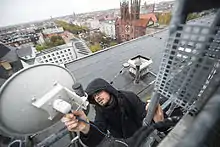Freifunk
Freifunk (German for: "free radio") is a non-commercial open grassroots initiative to support free computer networks in the German region. Freifunk is part of the international movement for a wireless community network. The initiative counts about 400 local communities[1] with over 41,000 access points.[2] Among them, Münster, Aachen, Munich, Stuttgart, and Paderborn are the biggest communities, with more than 1,000 access points each.[3]
| Freifunk | |
|---|---|
 | |
 Connections between nodes in Berlin | |
| Type | Data |
| Location | Germany |
| Established | September 2003 |
| Current status | Active |
| Commercial? | No |
| Website | freifunk |
Aim
The main goals of Freifunk are to build a large scale free wireless Wi-Fi network that is decentralized, owned by those who run it and to support local communication. The initiative is based on the Picopeering Agreement.[4] In this agreement, participants agree upon a network that is free from discrimination, in the sense of net neutrality. Similar grassroots initiatives in Austria and in Switzerland are FunkFeuer and Openwireless.
Technology
Like many other free community-driven networks, Freifunk uses mesh technology to bring up ad hoc networks by interconnecting multiple Wireless LANs. In a Wi-Fi mobile ad hoc network, all routers connect to each other using special routing software. When a router fails, this software automatically calculates a new route to the destination. This software, the Freifunk firmware, is based on OpenWrt and other free software.
There are several different implementations of the firmware depending on the hardware and protocols local communities use. The first Wi-Fi ad hoc network was done in Georgia, USA in 1999 as demonstrated by Toh.[5]It was a six-node implementation running the Associativity-Based Routing protocol on Linux kernel and WAVELAN WiFi. But ABR was a patented protocol. Following that experience, Freifunk work on standard IETF protocols - the two common standard proposals are OLSR and B.A.T.M.A.N.[6][7] The development of B.A.T.M.A.N. is driven by Freifunk activists on a volunteering basis.
History

One of the results of the BerLon workshop in October 2002 on free wireless community networks in Berlin and London was the Picopeering Agreement. This agreement about rationales of free networks describes how the transmission of other people's data is handled in a free network and has become a core agreement of the community. During the workshop, participants also agreed upon regular meetings in Berlin to build their own free wifi network. Ever since, there have been weekly meetings at c-base Hackerspace every Wednesday. At the same time, the German language site freifunk.net was started.
In September 2003, Freifunk activists founded the non-profit association Förderverein Freie Netzwerke e.V. to support free communication infrastructures.[8]
In the following years, the initiative became quite successful all over Germany, also because it became easier to install the Freifunk firmware on off-the-shelf wireless routers. There is a yearly Wireless Community Weekend taking place in Berlin, at c-base.
Legal Issues
In 2012, the Berlin Freifunk community got a lot of media attention for a project called Freifunk Freedom Fighter Box. The project fights secondary liability: Secondary liability is the legal situation that makes the owners of open / non-encrypted wireless access points liable for what other users do over their internet connection (i.e. guilty until proven innocent), as outlined in the Störerhaftung law (de).[9] The owners can thus be forced to pay for copyright infringements of third persons just because they opened their network to the public. This legal practice led to fear and uncertainty and made many people close their access points, e.g. in cafés or in public locations. The Freifunk Freedom Fighter Box was a preconfigured access point that sent all data from the public network to Sweden over a VPN connection. In Sweden (as in most other countries), there is no secondary liability.[10]
Outcome
In 2013, the Hamburg Freifunk community set up a network of more than 300 nodes,[11] using VPN tunnels to the Netherlands. Many new Freifunk communities emerged. In Berlin, the community is building a backbone network based on microwave transmission over longer distances. This project is funded by the local broadcasting corporation Medienanstalt Berlin-Brandenburg and is still on-going in Germany.
See also
References
- "Find you community (Community Finden)". Freifunk.net. Retrieved 7 August 2019.
- "Freifunk-Karte". Freifunk-karte.de. Retrieved 7 August 2019.
- "Community finden". Freifunk.net. Retrieved 7 August 2019.
- "Picopeering Agreement v1.0". Picopeer.net. Retrieved 7 August 2019.
- Toh, C.-K.; Chen, Richard; Delwar, Minar; Allen, Donald (December 6, 2000). "Experimenting with an Ad Hoc Wireless Network on Campus: Insights and Experiences". SIGMETRICS Perform. Eval. Rev. 28 (3): 21–29. doi:10.1145/377616.377622.
- "Technik der Community Netzwerke". Freifunk.net. Retrieved 7 August 2019.
- Wireless Networking in the Developing World. A practical guide to planning and building low-cost telecommunications infrastructure, Chapter 8: "Mesh Networking", pp. 134
- "Organisation". Foerderverein.frer-netzwerke.de. Retrieved 7 August 2019.
- Dobush, Grace. "Why is it impossible to find free wi-fi in Germany?". Qz.com. Retrieved 7 August 2019.
- "Freifunk Statt Angst". Writing.jan.io. Retrieved 7 August 2019.
- "Zugangspunkte". Hamburg.freifunk.net. Retrieved 7 August 2019.
External links
| Wikimedia Commons has media related to Freifunk. |
- Official website
- Video clip that explains the Freifunk idea on YouTube or Version in German with English subtitles on YouTube
- Freifunk firmware information in the Freifunk wiki (German only)
- Freifunk wiki (English-language category)
- Wireless Networking in the developing world. A practical guide to planning and building low-cost telecommunications infrastructure, 3rd edition, Feb. 2013